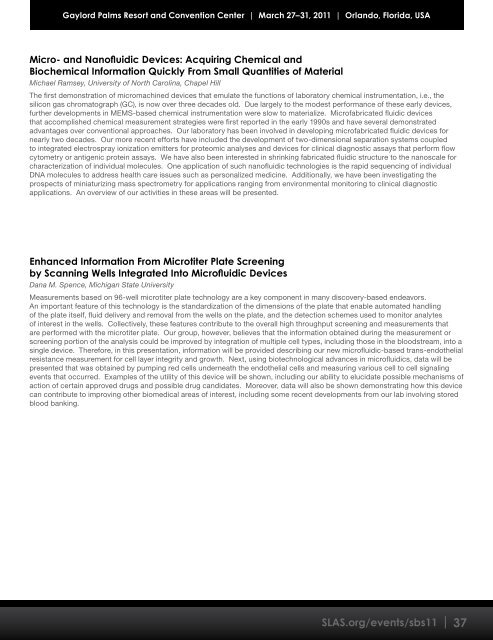Create successful ePaper yourself
Turn your PDF publications into a flip-book with our unique Google optimized e-Paper software.
Gaylord Palms Resort and Convention Center | March 27–31, <strong>2011</strong> | Orlando, Florida, USA<br />
Micro- and Nanofluidic Devices: Acquiring Chemical and<br />
Biochemical Information Quickly From Small Quantities of Material<br />
Michael Ramsey, University of North Carolina, Chapel Hill<br />
The first demonstration of micromachined devices that emulate the functions of labora<strong>to</strong>ry chemical instrumentation, i.e., the<br />
silicon gas chroma<strong>to</strong>graph (GC), is now over three decades old. Due largely <strong>to</strong> the modest performance of these early devices,<br />
further developments in MEMS-based chemical instrumentation were slow <strong>to</strong> materialize. Microfabricated fluidic devices<br />
that accomplished chemical measurement strategies were first reported in the early 1990s and have several demonstrated<br />
advantages over conventional approaches. Our labora<strong>to</strong>ry has been involved in developing microfabricated fluidic devices for<br />
nearly two decades. Our more recent efforts have included the development of two-dimensional separation systems coupled<br />
<strong>to</strong> integrated electrospray ionization emitters for proteomic analyses and devices for clinical diagnostic assays that perform flow<br />
cy<strong>to</strong>metry or antigenic protein assays. We have also been interested in shrinking fabricated fluidic structure <strong>to</strong> the nanoscale for<br />
characterization of individual molecules. One application of such nanofluidic technologies is the rapid sequencing of individual<br />
DNA molecules <strong>to</strong> address health care issues such as personalized medicine. Additionally, we have been investigating the<br />
prospects of miniaturizing mass spectrometry for applications ranging from environmental moni<strong>to</strong>ring <strong>to</strong> clinical diagnostic<br />
applications. An overview of our activities in these areas will be presented.<br />
Enhanced Information From Microtiter Plate Screening<br />
by Scanning Wells Integrated In<strong>to</strong> Microfluidic Devices<br />
Dana M. Spence, Michigan State University<br />
Measurements based on 96-well microtiter plate technology are a key component in many discovery-based endeavors.<br />
An important feature of this technology is the standardization of the dimensions of the plate that enable au<strong>to</strong>mated handling<br />
of the plate itself, fluid delivery and removal from the wells on the plate, and the detection schemes used <strong>to</strong> moni<strong>to</strong>r analytes<br />
of interest in the wells. Collectively, these features contribute <strong>to</strong> the overall high throughput screening and measurements that<br />
are performed with the microtiter plate. Our group, however, believes that the information obtained during the measurement or<br />
screening portion of the analysis could be improved by integration of multiple cell types, including those in the bloodstream, in<strong>to</strong> a<br />
single device. Therefore, in this presentation, information will be provided describing our new microfluidic-based trans-endothelial<br />
resistance measurement for cell layer integrity and growth. Next, using biotechnological advances in microfluidics, data will be<br />
presented that was obtained by pumping red cells underneath the endothelial cells and measuring various cell <strong>to</strong> cell signaling<br />
events that occurred. Examples of the utility of this device will be shown, including our ability <strong>to</strong> elucidate possible mechanisms of<br />
action of certain approved drugs and possible drug candidates. Moreover, data will also be shown demonstrating how this device<br />
can contribute <strong>to</strong> improving other biomedical areas of interest, including some recent developments from our lab involving s<strong>to</strong>red<br />
blood banking.<br />
<strong>SLAS</strong>.org/events/sbs11 | 37

















